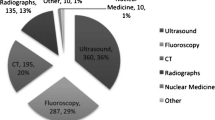Abstract
Background
The data concerning the value of a plain abdominal radiograph in childhood constipation are inconsistent. Recently, positive results have been reported of a new radiographic scoring system, "the Leech method", for assessing faecal loading.
Objective
To assess intra- and interobserver variability and determine diagnostic accuracy of the Leech method in identifying children with functional constipation (FC).
Materials and methods
A total of 89 children (median age 9.8 years) with functional gastrointestinal disorders were included in the study. Based on clinical parameters, 52 fulfilled the criteria for FC, six fulfilled the criteria for functional abdominal pain (FAP), and 31 for functional non-retentive faecal incontinence (FNRFI); the latter two groups provided the controls. To assess intra- and interobserver variability of the Leech method three scorers scored the same abdominal radiograph twice. A Leech score of 9 or more was considered as suggestive of constipation. ROC analysis was used to determine the diagnostic accuracy of the Leech method in separating patients with FC from control patients.
Results
Significant intraobserver variability was found between two scorers (P=0.005 and P<0.0001), whereas there was no systematic difference between the two scores of the other scorer (P=0.89). The scores between scorers differed systematically and displayed large variability. The area under the ROC curve was 0.68 (95% CI 0.58–0.80), indicating poor diagnostic accuracy.
Conclusions
The Leech scoring method for assessing faecal loading on a plain abdominal radiograph is of limited value in the diagnosis of FC in children.






Similar content being viewed by others
References
Barr RG, Levine MD, Wilkinson RH, et al (1979) Chronic and occult stool retention: a clinical tool for its evaluation in school-aged children. Clin Pediatr (Phila) 18:674–679
Blethyn AJ, Verrier JK, Newcombe R, et al (1995) Radiological assessment of constipation. Arch Dis Child 73:532–533
Benninga MA, Buller HA, Staalman CR, et al (1995) Defaecation disorders in children, colonic transit time versus the Barr-score. Eur J Pediatr 154:277–284
Tudor GR, Finlay D, Taub N (1997) An assessment of inter-observer agreement and accuracy when reporting plain radiographs. Clin Radiol 52:235–238
Zaslavsky C, da Silveira TR, Maguilnik I (1998) Total and segmental colonic transit time with radio-opaque markers in adolescents with functional constipation. J Pediatr Gastroenterol Nutr 27:138–142
Gutierrez C, Marco A, Nogales A, et al (2002) Total and segmental colonic transit time and anorectal manometry in children with chronic idiopathic constipation. J Pediatr Gastroenterol Nutr 35:31–38
de Lorijn F, van Wijk MP, Reitsma JB, et al (2004) Prognosis of constipation: clinical factors and colonic transit time. Arch Dis Child 89:723–727
Park ES, Park CI, Cho SR, et al (2004) Colonic transit time and constipation in children with spastic cerebral palsy. Arch Phys Med Rehabil 85:453–456
Leech SC, McHugh K, Sullivan PB (1999) Evaluation of a method of assessing faecal loading on plain abdominal radiographs in children. Pediatr Radiol 29:255–258
Loening-Baucke V (1990) Biofeedback therapy for faecal incontinence. Dig Dis 8:112–124
Rasquin-Weber A, Hyman PE, Cucchiara S, et al (1999) Childhood functional gastrointestinal disorders. Gut 45(Suppl 2):II60–II68
Benninga M, Candy DC, Catto-Smith AG, et al (2005) The Paris Consensus on Childhood Constipation Terminology (PACCT) Group. J Pediatr Gastroenterol Nutr 40:273–275
van der Plas RN, Benninga MA, Redekop WK, et al (1996) Randomised trial of biofeedback training for encopresis. Arch Dis Child 75:367–374
Bouchoucha M, Devroede G, Arhan P, et al (1992) What is the meaning of colorectal transit time measurement? Dis Colon Rectum 35:773–782
Metcalf AM, Phillips SF, Zinsmeister AR, et al (1987) Simplified assessment of segmental colonic transit. Gastroenterology 92:40–47
Arhan P, Devroede G, Jehannin B, et al (1981) Segmental colonic transit time. Dis Colon Rectum 24:625–629
Bland JM, Altman DG (1986) Statistical methods for assessing agreement between two methods of clinical measurement. Lancet 1(8476):307–310
DeLong ER, DeLong DM, Clarke-Pearson DL (1988) Comparing the areas under two or more correlated receiver operating characteristic curves: a nonparametric approach. Biometrics 44:837–845
Youden WJ (1950) Index for rating diagnostic tests. Cancer 3:32–35
Afzal N, Murch S, Thirrupathy K, et al (2003) Constipation with acquired megarectum in children with autism. Pediatrics 112:939–942
Quinn MF (1989) Relation of observer agreement to accuracy according to a two-receiver signal detection model of diagnosis. Med Decis Making 9:196–206
Boyd NF, Wolfson C, Moskowitz M, et al (1982) Observer variation in the interpretation of xeromammograms. J Natl Cancer Inst 68:357–363
Wald A (1986) Colonic transit and anorectal manometry in chronic idiopathic constipation. Arch Intern Med 146:1713–1716
Papadopoulou A, Clayden GS, Booth IW (1994) The clinical value of solid marker transit studies in childhood constipation and soiling. Eur J Pediatr 153:560–564
Reuchlin-Vroklage LM, Bierma-Zeinstra S, Benninga MA, et al (2005) Diagnostic value of abdominal radiography in constipated children: a systematic review. Arch Pediatr Adolesc Med 159:671–678
van der Plas RN, Benninga MA, Redekop WK, et al (1997) How accurate is the recall of bowel habits in children with defaecation disorders? Eur J Pediatr 156:178–181
Benninga MA, Buller HA, Heymans HS, et al (1994) Is encopresis always the result of constipation? Arch Dis Child 71:186–193
Voskuijl WP, Heijmans J, Heijmans HS, et al (2004) Use of Rome II criteria in childhood defecation disorders: applicability in clinical and research practice. J Pediatr 145:213–217
Author information
Authors and Affiliations
Corresponding author
Rights and permissions
About this article
Cite this article
de Lorijn, F., van Rijn, R.R., Heijmans, J. et al. The Leech method for diagnosing constipation: intra- and interobserver variability and accuracy. Pediatr Radiol 36, 43–49 (2006). https://doi.org/10.1007/s00247-005-0031-z
Received:
Revised:
Accepted:
Published:
Issue Date:
DOI: https://doi.org/10.1007/s00247-005-0031-z




